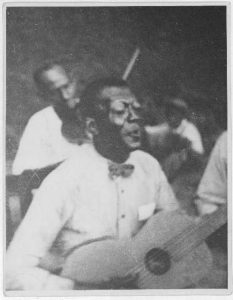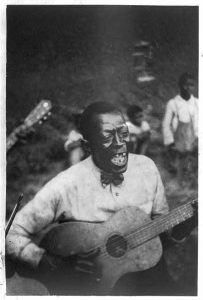Often times, stories that exemplify this mix come out in African American blues tunes. Coming from the African American work song tradition, a crucial part of these tunes is that they tell a story. One blues, in particular “Stavin’ Chain” tells the story of a train engineer. He was hailed as strong and powerful. This figure was so strong and unique that Wilson Jones, one of the artists who recorded a version of “Stavin’ Chain” also went by the nickname, “Stavin’ Chain.”
This begs the question for the story how Wilson Jones came to adopt “Stavin Chain.”

[Stavin’ Chain playing guitar and singing the ballad “Batson,” Lafayette, La. (fiddler in the background)]
Nevertheless, Wilson Jones became “Stavin Chain,” a figure of strength and prominence. This term may refer to the American tradition of arms manufactures in the late 19th century utilizing chains to hold barrel staves together, or perhaps it refers to chains used to bind ankles on chain work gangs (Americanbluesscene.com). I believe that this term could easily have come from a blend of the two stories, as African American folk so heavily relies upon cultural blending.
–Brock Carlson
Works cited
Lomax, A., photographer. (1934) [Stavin’ Chain playing guitar and singing the ballad “Batson,” fiddler also in shot, Lafayette, La]. Lafayette Louisiana United States, 1934. June. [Photograph] Retrieved from the Library of Congress, https://www.loc.gov/item/2007660068/.
Lomax, A., photographer. (1934) [Stavin’ Chain playing guitar and singing the ballad “Batson,” Lafayette, La]. Lafayette Louisiana United States, 1934. June. [Photograph] Retrieved from the Library of Congress, https://www.loc.gov/item/2007660069/.
Lomax, A., photographer. (1934) [Stavin’ Chain playing guitar and singing the ballad “Batson,” Lafayette, La. fiddler in the background]. Lafayette Louisiana United States, 1934. June. [Photograph] Retrieved from the Library of Congress, https://www.loc.gov/item/2007660070/.
Baraka, A., & Harris, W. J. (2000). The LeRoi Jones/Amiri Baraka reader. New York: Thunders Mouth Press.


